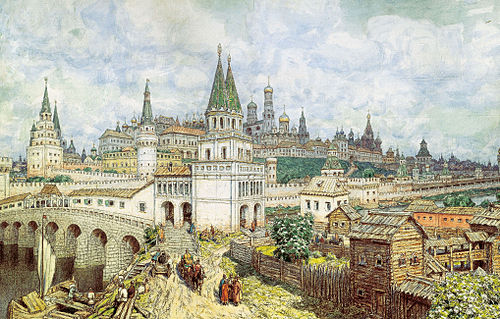Great Stone Bridge
| Object of cultural heritage of Russia of regional significance reg. No. 771510260500005(EGROKN) object No. 7735352000(Wikigida DB) |

All Saints Bridge at the end of the 17th century, drawing by A. Vasnetsov
All Saints Bridge
On the site of the later bridge, apparently from the very beginning of Moscow, there was a ford through which the road from Ryazan to Novgorod went through Volok Lamsky, known as Volotskaya. Then a floating (“living”) bridge was built, which was raised to allow ships to pass through. Against the bridge at the end of the 16th century. The All Saints (Water) Gate of the White City was built, so named after the Church of All Saints, which stood nearby (near the modern Cathedral of Christ the Savior), on the moat. In 1643, by decree of Tsar Mikhail Fedorovich, a master from Strasbourg, Yagon Christler, began construction of the first permanent stone bridge across the Moscow River at the All Saints Gate. After the death of the king and the master, construction was stopped, as the plan was considered too bold and expensive. It was resumed and completed in -1687 on the initiative of Princess Sophia and Vasily Golitsyn according to the old model of Christler (who left behind a wooden model of the bridge) of the “bridge stone craftsman” monk Elder Philaret. After completion in 1692, the bridge received the name All Saints. Other names of the bridge were: Bersenevsky and New Kamenny (Old Kamenny meant the Trinity Bridge over the Neglinka, near the Trinity Tower of the Kremlin). Over time, the bridge acquired its modern name. The bridge was, however, not exactly on the modern site: it began at the foot of the modern House on the Embankment (the red line of which is correlated with the line of the old bridge) and led to the place where Lenivka Street now opens to the river (in those days it was a passage to All Saints Gate).
The length of the bridge was 170 m, the width was 22 m. The bridge had 8 arches, the middle ones served to pass rafts and boats and had spans of up to 15 m. In front of the bridge on the Zamoskvoretsk side, a bridgehead tower was built - Shestivratnaya, which, as the name indicates, had six gate openings (actually three double gates), as well as several pyramidal tiers, correlated with the tiers of the Borovitskaya tower of the Kremlin, and two crowning tents crowned with double-headed eagles.
The funds spent on the construction of the bridge so amazed contemporaries that a saying arose that existed in Moscow for more than a hundred and fifty years: “More expensive than the Stone Bridge!” (about the value and high cost of something). In the 19th century, a saying was also recorded in the Nizhny Novgorod province: “A stone bridge is better!” In general, according to the testimony of Moscow historian I.M. Snegirev, who still saw the old bridge, it “was considered one of the capital’s wonders, on a par with Ivan the Great, the Sukharev Tower, the Tsar Bell, and the Tsar Cannon.”
Since the bridge was 3-4 times wider than the largest Moscow streets, it was built up on both sides. In Peter’s times, on the bridge stood: the chamber of the Predtechevsky Monastery and four stone tents of Prince Menshikov, a tobacco customs house and a beer yard. At the end of the bridge there was a tavern called “Zavernyayka”. The Six Gate Tower housed the Tavern Office and a prison for those convicted of tavern (secretly making wine). Below them were galleries called upper walkways, where Muscovites gathered to walk and drink wine and beer; from the galleries a wooden ramp led to the embankment, to the so-called Tsaritsyn meadow and to Bersenevka. There was a beer glacier right under the bridge. Water-powered flour mills with dams and diversion gates were attached to the diversion bulls; the millers lived right there, in the Six Gate Tower.
All sorts of “thieves” and “dashing people” gathered under the bridge, and one of the spans on the left bank, the “ninth cell,” was especially notorious. As evening approached, Muscovites tried not to walk past it.
In 1731, by decree of Anna Ioannovna, the mills were demolished and the bridge piers were cleared. During the spring flood of 1783, the bridge was badly damaged: as Moscow commander-in-chief Count Chernyshev reported to Catherine: “Three arches of the bridge collapsed... and the 11 stone shops on them with various furniture of the merchant Yepanishnikov, worth 1100 rubles. One who was standing on the bridge at that time fell and was killed, and the ruins crushed a fisherman who was under the bridge and two women who were at the shore to wash their clothes.” In August 1786, the bridge was again damaged by floods. In view of this, by order of the new commander-in-chief, Earl Bruce, the bridge was repaired and reconstructed. During the reconstruction, which lasted until 1792 and cost 213,000 rubles, the bridge was strengthened, the benches were demolished, the Six Gate Tower was dismantled, and railings were installed on the sides.
In the mid-1850s. It was decided to demolish the dilapidated bridge. The demolition was carried out with great difficulty, due to the strength of the masonry, which had to be blown up. “How much effort and dedication it took to break this two-century-old monument! - writes I.M. Snegirev, who witnessed its destruction. - The very difficulty of breaking it proved the strength of its masonry and the goodness of the material, from which only one part was enough to build a huge house. Moscow residents gathered with curiosity and regret to look at the destruction of this bridge, which had long been revered as one of the wonders not only of our ancient capital, but of all of Russia in general.”

